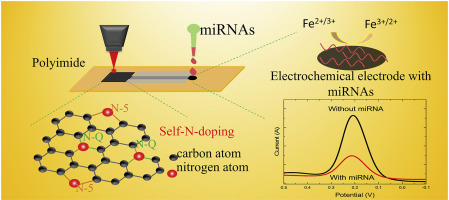Our official English website, www.x-mol.net, welcomes your
feedback! (Note: you will need to create a separate account there.)
Laser induced self-N-doped porous graphene as an electrochemical biosensor for femtomolar miRNA detection
Carbon ( IF 10.5 ) Pub Date : 2020-08-01 , DOI: 10.1016/j.carbon.2020.03.043 Zhengfen Wan , Muhammad Umer , Mirko Lobino , David Thiel , Nam-Trung Nguyen , Adrian Trinchi , Muhammad J.A. Shiddiky , Yongsheng Gao , Qin Li
Carbon ( IF 10.5 ) Pub Date : 2020-08-01 , DOI: 10.1016/j.carbon.2020.03.043 Zhengfen Wan , Muhammad Umer , Mirko Lobino , David Thiel , Nam-Trung Nguyen , Adrian Trinchi , Muhammad J.A. Shiddiky , Yongsheng Gao , Qin Li

|
Abstract We report a sensitive, yet low-cost biosensor based on laser induced graphene for femtomolar microRNA (miRNA) detection. Combined with the miRNA extraction and magnetic isolation process, the target miRNAs were purified for further detection using laser induced graphene sensor. The laser induced graphene was prepared by direct laser writing on commercial polyimide (PI) and patterned via a computer-aided design system as an electrode for electrochemical biosensing. We found that the laser reduction of PI resulted in nitrogen-doped porous graphene, not only improving its conductivity but also its sensitivity to nucleic acids. Preeclampsia specific miRNA hsa-miR-486-5p was magnetically purified and directly adsorbed on the surface of graphene electrode via graphene-miRNA affinity interaction. Surface attached miRNAs were then electrochemically quantified using [Fe(CN)6]3-/4- redox system. Our assay demonstrates detection of miRNA has-miR-486-5p up to concentrations as low as 10 fM with excellent reproducibility. Owing to its facile fabrication, low cost and high performance, the laser induced N-doped graphene biosensor presented here shows great potential for applications in detecting miRNA in biomedical applications.
中文翻译:

激光诱导自掺杂多孔石墨烯作为用于飞摩尔 miRNA 检测的电化学生物传感器
摘要 我们报告了一种基于激光诱导石墨烯的灵敏且低成本的生物传感器,用于飞摩尔微 RNA (miRNA) 检测。结合miRNA提取和磁分离过程,纯化目标miRNA以使用激光诱导石墨烯传感器进一步检测。激光诱导石墨烯是通过在商用聚酰亚胺 (PI) 上直接激光写入制备的,并通过计算机辅助设计系统进行图案化,作为电化学生物传感的电极。我们发现 PI 的激光还原导致了氮掺杂的多孔石墨烯,不仅提高了它的导电性,而且提高了它对核酸的敏感性。先兆子痫特异性 miRNA hsa-miR-486-5p 被磁性纯化并通过石墨烯-miRNA 亲和相互作用直接吸附在石墨烯电极表面。然后使用 [Fe(CN)6]3-/4-氧化还原系统对表面附着的 miRNA 进行电化学定量。我们的检测证明了 miRNA has-miR-486-5p 的检测浓度低至 10 fM,并具有出色的重现性。由于其易于制造、低成本和高性能,这里介绍的激光诱导 N 掺杂石墨烯生物传感器在生物医学应用中检测 miRNA 方面显示出巨大的应用潜力。
更新日期:2020-08-01
中文翻译:

激光诱导自掺杂多孔石墨烯作为用于飞摩尔 miRNA 检测的电化学生物传感器
摘要 我们报告了一种基于激光诱导石墨烯的灵敏且低成本的生物传感器,用于飞摩尔微 RNA (miRNA) 检测。结合miRNA提取和磁分离过程,纯化目标miRNA以使用激光诱导石墨烯传感器进一步检测。激光诱导石墨烯是通过在商用聚酰亚胺 (PI) 上直接激光写入制备的,并通过计算机辅助设计系统进行图案化,作为电化学生物传感的电极。我们发现 PI 的激光还原导致了氮掺杂的多孔石墨烯,不仅提高了它的导电性,而且提高了它对核酸的敏感性。先兆子痫特异性 miRNA hsa-miR-486-5p 被磁性纯化并通过石墨烯-miRNA 亲和相互作用直接吸附在石墨烯电极表面。然后使用 [Fe(CN)6]3-/4-氧化还原系统对表面附着的 miRNA 进行电化学定量。我们的检测证明了 miRNA has-miR-486-5p 的检测浓度低至 10 fM,并具有出色的重现性。由于其易于制造、低成本和高性能,这里介绍的激光诱导 N 掺杂石墨烯生物传感器在生物医学应用中检测 miRNA 方面显示出巨大的应用潜力。











































 京公网安备 11010802027423号
京公网安备 11010802027423号